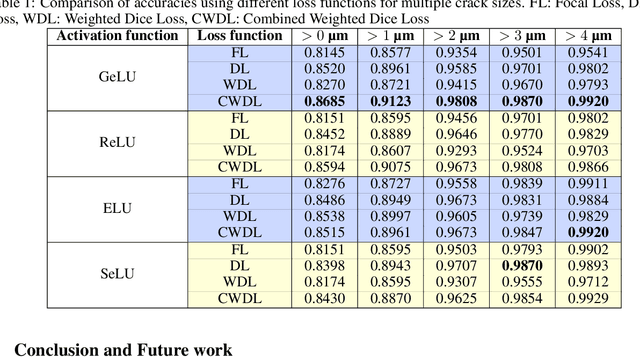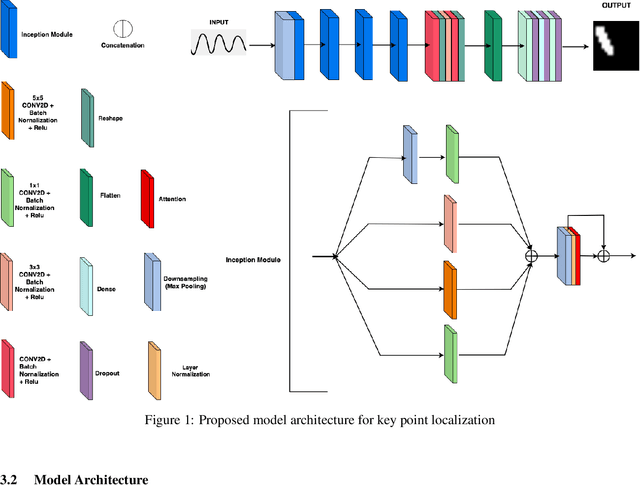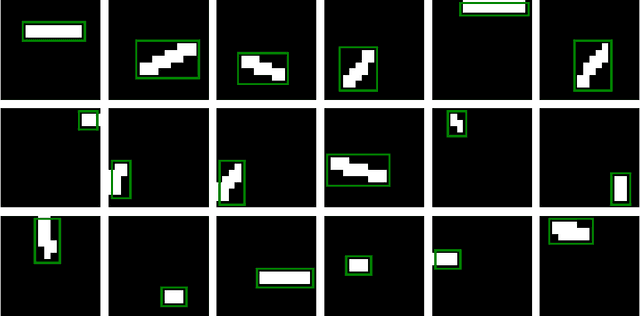Sven Tomforde
Christian Albrechts University, Kiel, Germany
MicroCrackAttentionNeXt: Advancing Microcrack Detection in Wave Field Analysis Using Deep Neural Networks through Feature Visualization
Nov 15, 2024



Abstract:Micro Crack detection using deep neural networks (DNNs) through an automated pipeline using wave fields interacting with the damaged areas is highly sought after. These high-dimensional spatio-temporal crack data are limited, and these datasets have large dimensions in the temporal domain. The dataset presents a substantial class imbalance, with crack pixels constituting an average of only 5% of the total pixels per sample. This extreme class imbalance poses a challenge for deep learning models with the different micro-scale cracks, as the network can be biased toward predicting the majority class, generally leading to poor detection accuracy. This study builds upon the previous benchmark SpAsE-Net, an asymmetric encoder-decoder network for micro-crack detection. The impact of various activation and loss functions were examined through feature space visualization using the manifold discovery and analysis (MDA) algorithm. The optimized architecture and training methodology achieved an accuracy of 86.85%.
Deep Learning for Micro-Scale Crack Detection on Imbalanced Datasets Using Key Point Localization
Nov 15, 2024



Abstract:Internal crack detection has been a subject of focus in structural health monitoring. By focusing on crack detection in structural datasets, it is demonstrated that deep learning (DL) methods can effectively analyze seismic wave fields interacting with micro-scale cracks, which are beyond the resolution of conventional visual inspection. This work explores a novel application of DL-based key point detection technique, where cracks are localized by predicting the coordinates of four key points that define a bounding region of the crack. The study not only opens new research directions for non-visual applications but also effectively mitigates the impact of imbalanced data which poses a challenge for previous DL models, as it can be biased toward predicting the majority class (non-crack regions). Popular DL techniques, such as the Inception blocks, are used and investigated. The model shows an overall reduction in loss when applied to micro-scale crack detection and is reflected in the lower average deviation between the location of actual and predicted cracks, with an average Intersection over Union (IoU) being 0.511 for all micro cracks (greater than 0.00 micrometers) and 0.631 for larger micro cracks (greater than 4 micrometers).
Fault Detection for agents on power grid topology optimization: A Comprehensive analysis
Jun 24, 2024



Abstract:The topology optimization of transmission networks using Deep Reinforcement Learning (DRL) has increasingly come into focus. Various researchers have proposed different DRL agents, which are often benchmarked on the Grid2Op environment from the Learning to Run a Power Network (L2RPN) challenges. The environments have many advantages with their realistic chronics and underlying power flow backends. However, the interpretation of agent survival or failure is not always clear, as there are a variety of potential causes. In this work, we focus on the failures of the power grid to identify patterns and detect them a priori. We collect the failed chronics of three different agents on the WCCI 2022 L2RPN environment, totaling about 40k data points. By clustering, we are able to detect five distinct clusters, identifying different failure types. Further, we propose a multi-class prediction approach to detect failures beforehand and evaluate five different models. Here, the Light Gradient-Boosting Machine (LightGBM) shows the best performance, with an accuracy of 86%. It also correctly identifies in 91% of the time failure and survival observations. Finally, we provide a detailed feature importance analysis that identifies critical features and regions in the grid.
HUGO -- Highlighting Unseen Grid Options: Combining Deep Reinforcement Learning with a Heuristic Target Topology Approach
May 01, 2024Abstract:With the growth of Renewable Energy (RE) generation, the operation of power grids has become increasingly complex. One solution is automated grid operation, where Deep Reinforcement Learning (DRL) has repeatedly shown significant potential in Learning to Run a Power Network (L2RPN) challenges. However, only individual actions at the substation level have been subjected to topology optimization by most existing DRL algorithms. In contrast, we propose a more holistic approach in this paper by proposing specific Target Topologies (TTs) as actions. These topologies are selected based on their robustness. As part of this paper, we present a search algorithm to find the TTs and upgrade our previously developed DRL agent CurriculumAgent (CAgent) to a novel topology agent. We compare the upgrade to the previous CAgent agent and can increase their scores significantly by 10%. Further, we achieve a 25% better median survival with our TTs included. Later analysis shows that almost all TTs are close to the base topology, explaining their robustness.
Exploring the Dynamics of Data Transmission in 5G Networks: A Conceptual Analysis
Apr 25, 2024



Abstract:This conceptual analysis examines the dynamics of data transmission in 5G networks. It addresses various aspects of sending data from cameras and LiDARs installed on a remote-controlled ferry to a land-based control center. The range of topics includes all stages of video and LiDAR data processing from acquisition and encoding to final decoding, all aspects of their transmission and reception via the WebRTC protocol, and all possible types of network problems such as handovers or congestion that could affect the quality of experience for end-users. A series of experiments were conducted to evaluate the key aspects of the data transmission. These include simulation-based reproducible runs and real-world experiments conducted using open-source solutions we developed: "Gymir5G" - an OMNeT++-based 5G simulation and "GstWebRTCApp" - a GStreamer-based application for adaptive control of media streams over the WebRTC protocol. One of the goals of this study is to formulate the bandwidth and latency requirements for reliable real-time communication and to estimate their approximate values. This goal was achieved through simulation-based experiments involving docking maneuvers in the Bay of Kiel, Germany. The final latency for the entire data processing pipeline was also estimated during the real tests. In addition, a series of simulation-based experiments showed the impact of key WebRTC features and demonstrated the effectiveness of the WebRTC protocol, while the conducted video codec comparison showed that the hardware-accelerated H.264 codec is the best. Finally, the research addresses the topic of adaptive communication, where the traditional congestion avoidance and deep reinforcement learning approaches were analyzed. The comparison in a sandbox scenario shows that the AI-based solution outperforms the WebRTC baseline GCC algorithm in terms of data rates, latency, and packet loss.
BirdSet: A Multi-Task Benchmark for Classification in Avian Bioacoustics
Mar 15, 2024Abstract:Deep learning (DL) models have emerged as a powerful tool in avian bioacoustics to diagnose environmental health and biodiversity. However, inconsistencies in research pose notable challenges hindering progress in this domain. Reliable DL models need to analyze bird calls flexibly across various species and environments to fully harness the potential of bioacoustics in a cost-effective passive acoustic monitoring scenario. Data fragmentation and opacity across studies complicate a comprehensive evaluation of general model performance. To overcome these challenges, we present the BirdSet benchmark, a unified framework consolidating research efforts with a holistic approach for classifying bird vocalizations in avian bioacoustics. BirdSet harmonizes open-source bird recordings into a curated dataset collection. This unified approach provides an in-depth understanding of model performance and identifies potential shortcomings across different tasks. By establishing baseline results of current models, BirdSet aims to facilitate comparability, guide subsequent data collection, and increase accessibility for newcomers to avian bioacoustics.
Active Bird2Vec: Towards End-to-End Bird Sound Monitoring with Transformers
Aug 14, 2023
Abstract:We propose a shift towards end-to-end learning in bird sound monitoring by combining self-supervised (SSL) and deep active learning (DAL). Leveraging transformer models, we aim to bypass traditional spectrogram conversions, enabling direct raw audio processing. ActiveBird2Vec is set to generate high-quality bird sound representations through SSL, potentially accelerating the assessment of environmental changes and decision-making processes for wind farms. Additionally, we seek to utilize the wide variety of bird vocalizations through DAL, reducing the reliance on extensively labeled datasets by human experts. We plan to curate a comprehensive set of tasks through Huggingface Datasets, enhancing future comparability and reproducibility of bioacoustic research. A comparative analysis between various transformer models will be conducted to evaluate their proficiency in bird sound recognition tasks. We aim to accelerate the progression of avian bioacoustic research and contribute to more effective conservation strategies.
Managing power grids through topology actions: A comparative study between advanced rule-based and reinforcement learning agents
Apr 17, 2023Abstract:The operation of electricity grids has become increasingly complex due to the current upheaval and the increase in renewable energy production. As a consequence, active grid management is reaching its limits with conventional approaches. In the context of the Learning to Run a Power Network challenge, it has been shown that Reinforcement Learning (RL) is an efficient and reliable approach with considerable potential for automatic grid operation. In this article, we analyse the submitted agent from Binbinchen and provide novel strategies to improve the agent, both for the RL and the rule-based approach. The main improvement is a N-1 strategy, where we consider topology actions that keep the grid stable, even if one line is disconnected. More, we also propose a topology reversion to the original grid, which proved to be beneficial. The improvements are tested against reference approaches on the challenge test sets and are able to increase the performance of the rule-based agent by 27%. In direct comparison between rule-based and RL agent we find similar performance. However, the RL agent has a clear computational advantage. We also analyse the behaviour in an exemplary case in more detail to provide additional insights. Here, we observe that through the N-1 strategy, the actions of the agents become more diversified.
Active Reinforcement Learning -- A Roadmap Towards Curious Classifier Systems for Self-Adaptation
Jan 11, 2022



Abstract:Intelligent systems have the ability to improve their behaviour over time taking observations, experiences or explicit feedback into account. Traditional approaches separate the learning problem and make isolated use of techniques from different field of machine learning such as reinforcement learning, active learning, anomaly detection or transfer learning, for instance. In this context, the fundamental reinforcement learning approaches come with several drawbacks that hinder their application to real-world systems: trial-and-error, purely reactive behaviour or isolated problem handling. The idea of this article is to present a concept for alleviating these drawbacks by setting up a research agenda towards what we call "active reinforcement learning" in intelligent systems.
Collaborative Interactive Learning -- A clarification of terms and a differentiation from other research fields
May 16, 2019Abstract:The field of collaborative interactive learning (CIL) aims at developing and investigating the technological foundations for a new generation of smart systems that support humans in their everyday life. While the concept of CIL has already been carved out in detail (including the fields of dedicated CIL and opportunistic CIL) and many research objectives have been stated, there is still the need to clarify some terms such as information, knowledge, and experience in the context of CIL and to differentiate CIL from recent and ongoing research in related fields such as active learning, collaborative learning, and others. Both aspects are addressed in this paper.
 Add to Chrome
Add to Chrome Add to Firefox
Add to Firefox Add to Edge
Add to Edge